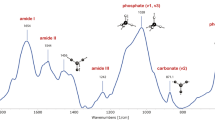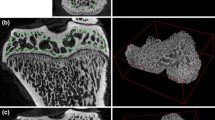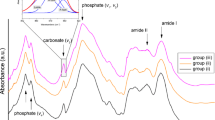Abstract
Pharmacological therapy of osteoporosis reduces bone loss and risk of fracture in patients. Modulation of bone mineral density cannot explain all effects. Other aspects of bone quality affecting fragility and ways to monitor them need to be better understood. Keratinous tissue acts as surrogate marker for bone protein deterioration caused by oestrogen deficiency in rats. Ovariectomised rats were treated with alendronate (ALN), parathyroid hormone (PTH) or estrogen (E2). MicroCT assessed macro structural changes. Raman spectroscopy assessed biochemical changes. Micro CT confirmed that all treatments prevented ovariectomy-induced macro structural bone loss in rats. PTH induced macro structural changes unrelated to ovariectomy. Raman analysis revealed ALN and PTH partially protect against molecular level changes to bone collagen (80% protection) and mineral (50% protection) phases. E2 failed to prevent biochemical change. The treatments induced alterations unassociated with the ovariectomy; increased beta sheet with E2, globular alpha helices with PTH and fibrous alpha helices with both ALN and PTH. ALN is closest to maintaining physiological status of the animals, while PTH (comparable protective effect) induces side effects. E2 is unable to prevent molecular level changes associated with ovariectomy. Raman spectroscopy can act as predictive tool for monitoring pharmacological therapy of osteoporosis in rodents. Keratinous tissue is a useful surrogate marker for the protein related impact of these therapies.The results demonstrate utility of surrogates where a clear systemic causation connects the surrogate to the target tissue. It demonstrates the need to assess broader biomolecular impact of interventions to examine side effects.

Highlights
-
Osteoporotic treatments exhibit substantial differences in biochemical impact.
-
Alendronate preserved the bone tissue in the state closest to the sham group.
-
Parathyroid hormone prevents ovariectomy changes, induces different changes.
-
Estrogen preserves tissue macro structure, but unable to prevent biochemical changes.
-
Systemic conditions affect structural proteins in both bone and claw.





Similar content being viewed by others
Abbreviations
- ALN:
-
alendronate
- PTH:
-
parathyroid hormone
- E2:
-
estrogen
- OVX:
-
ovariectomised (untreated)
- OVXA:
-
ovariectomised treated with alendronate
- OVXE:
-
ovariectomised treated with estrogen
- OVXP:
-
ovariectomised treated with parathyroid hormone
- SEM:
-
standard error of the mean
- BMD:
-
bone mineral density
- DXA:
-
Dual energy X-ray Absorptiometry
- microCT:
-
micro computed tomography
- PCA:
-
Principle Component Analysis
- LDA:
-
linear discriminant analysis
- AUCROC:
-
area under the curve for the receiver operator characteristics
- ROI:
-
region of interest
References
NIH Consensus Development Panel on Osteoporosis Prevention, Diagnosis, and Therapy. Osteoporosis prevention, diagnosis, and therapy. JAMA 2001;285:785–95. https://doi.org/10.1001/jama.285.6.785
Viguet-Carrin S, Garnero P, Delmas PD. The role of collagen in bone strength. Osteoporos Int. 2006;17:319–36. https://doi.org/10.1007/s00198-005-2035-9
Cummins NM, Day JCC, Wren A, Carroll P, Murphy N, Jakeman PM et al. Raman spectroscopy of fingernails: a novel tool for evaluation of bone quality? Spectroscopy. 2010;24:517–24. https://doi.org/10.3233/SPE-2010-0471
Towler MR, Wren A, Rushe N, Saunders J, Cummins NM, Jakeman PM. Raman spectroscopy of the human nail: a potential tool for evaluating bone health? J Mater Sci Mater Med. 2007;18:759–63. https://doi.org/10.1007/s10856-006-0018-9
Moran P, Towler MR, Chowdhury S, Saunders J, German MJ, Lawson NS et al. Preliminary work on the development of a novel detection method for osteoporosis. J Mater Sci Mater Med. 2007;18:969–74. https://doi.org/10.1007/s10856-006-0037-6
Pillay I, Lyons D, German MJ, Lawson NS, Pollock HM, Saunders J et al. The use of fingernails as a means of assessing bone health: a pilot study. J Women’s Health (Larchmt). 2005;14:339–44. https://doi.org/10.1089/jwh.2005.14.339
Beattie JR, Cummins NM, Caraher C, O’Driscoll OM, Bansal AT, Eastell R et al. Raman spectroscopic analysis of fingernail clippings can help differentiate between postmenopausal women who have and have not suffered a fracture. Clin Med Insights Arthritis Musculoskelet Disord. 2016;9:109–16. https://doi.org/10.4137/CMAMD.S38493
Beattie JR, Caraher MC, Cummins NM, O’Driscoll OM, Eastell R, Ralston SH et al. Raman spectral variation for human fingernails of postmenopausal women is dependent on fracture risk and osteoporosis status. J Raman Spectrosc. 2017;48:813–21. https://doi.org/10.1002/jrs.5123
Beattie JR, Feskanich D, Caraher MC, Towler MR. A preliminary evaluation of the ability of keratotic tissue to act as a prognostic indicator of hip fracture risk. Clin Med Insights Arthritis Musculoskelet Disord. 2018;11:117954411775405 https://doi.org/10.1177/1179544117754050
Caraher MC, Sophocleous A, Beattie JR, O’Driscoll O, Cummins NM, Brennan O et al. Raman spectroscopy predicts the link between claw keratin and bone collagen structure in a mouse model of oestrogen deficiency. Biochim Biophisica Acta Mol Basis Dis. 2018;1864:398–406.
Bruyere O, Roux C, Detilleux J, Slosman DO, Spector TD, Fardellone P et al. Relationship between bone mineral density changes and fracture risk reduction in patients treated with strontium ranelate. J Clin Endocrinol Metab. 2007;92:3076–81. https://doi.org/10.1210/jc.2006-2758
Cummings SR, Karpf DB, Harris F, Genant HK, Ensrud K, LaCroix AZ et al. Improvement in spine bone density and reduction in risk of vertebral fractures during treatment with antiresorptive drugs. Am J Med. 2002;112:281–9. https://doi.org/10.1016/S0002-9343(01)01124-X
Guo R-T, Cao R, Liang P-H, Ko T-P, Chang T-H, Hudock MP et al. Bisphosphonates target multiple sites in both cis- and trans-prenyltransferases. Proc Natl Acad Sci USA. 2007;104:10022–7. https://doi.org/10.1073/pnas.0702254104
Liberman UA, Weiss SR, Bröll J, Minne HW, Quan H, Bell NH et al. Effect of oral alendronate on bone mineral density and the incidence of fractures in postmenopausal osteoporosis. N Engl J Med. 1995;333:1437–44. https://doi.org/10.1056/NEJM199511303332201
Black DM, Thompson DE, Bauer DC, Ensrud K, Musliner T, Hochberg MC et al. Fracture risk reduction with alendronate in women with osteoporosis: the fracture intervention trial. J Clin Endocrinol Metab. 2000;85:4118–24. https://doi.org/10.1210/jcem.85.11.6953
Black DM, Cummings SR, Karpf DB, Cauley JA, Thompson DE, Nevitt MC et al. Randomised trial of effect of alendronate on risk of fracture in women with existing vertebral fractures. Lancet. 1996;348:1535–41. https://doi.org/10.1016/S0140-6736(96)07088-2
Cummings SR, Black DM, Thompson DE, Applegate WB, Barrett-Connor E, Musliner TA et al. Effect of alendronate on risk of fracture in women with low bone density but without vertebral fractures: results from the fracture intervention trial. JAMA. 1998;280:2077 https://doi.org/10.1001/jama.280.24.2077
Cauley JA, Seeley DG, Ensrud K, Ettinger B, Black D, Cummings SR. Estrogen replacement therapy and fractures in older women. Ann Intern Med. 1995;122:9 https://doi.org/10.7326/0003-4819-122-1-199501010-00002
Khajuria DK, Razdan R, Mahapatra DR. Drugs for the management of osteoporosis: a review. Rev Bras Reumatol. 2011;51:372–82. https://doi.org/10.1590/S0482-50042011000400008
Dede AD, Makras P, Anastasilakis AD. Investigational anabolic agents for the treatment of osteoporosis: an update on recent developments. Expert Opin Investig Drugs. 2017;26:1137–44. https://doi.org/10.1080/13543784.2017.1371136
Neer RM, Arnaud CD, Zanchetta JR, Prince R, Gaich GA, Reginster J-Y et al. Effect of parathyroid Hormone (1-34) on fractures and bone mineral density in postmenopausal women with osteoporosis. N Engl J Med. 2001;344:1434–41. https://doi.org/10.1056/NEJM200105103441904
Trevisani VFM, Riera R, Imoto AM, Saconato H, Atallah ÁN. Teriparatide (recombinant human parathyroid hormone 1-34) in postmenopausal women with osteoporosis: systematic review. Sao Paulo Med J. 2008;126:279–84. https://doi.org/10.1590/S1516-31802008000500007.
A Sophocleous, AI Idris, Rodent models of osteoporosis, Bonekey Rep. 3 (2014). https://doi.org/10.1038/bonekey.2014.109
Beattie JR. Optimising reproducibility in low quality signals without smoothing; an alternative paradigm for signal processing. J Raman Spectrosc. 2011;42:1419–27. https://doi.org/10.1002/jrs.2851
Beattie JR, McGarvey JJ. Estimation of signal backgrounds on multivariate loadings improves model generation in face of complex variation in backgrounds and constituents. J Raman Spectrosc. 2013;44:329–38. https://doi.org/10.1002/jrs.4178
Beattie JR, Glenn JV, Boulton ME, Stitt AW, McGarvey JJ. Effect of signal intensity normalization on the multivariate analysis of spectral data in complex “real-world” datasets. J Raman Spectrosc. 2009;40:429–35. https://doi.org/10.1002/jrs.2146
Palacký J, Mojzeš P, Bok J. SVD-based method for intensity normalization, background correction and solvent subtraction in Raman spectroscopy exploiting the properties of water stretching vibrations. J Raman Spectrosc. 2011;42:1528–39. https://doi.org/10.1002/jrs.2896
Mandair GS, Esmonde-White FWL, Akhter MP, Swift AM, Kreider J, Goldstein SA et al. Potential of Raman spectroscopy for evaluation of bone quality in osteoporosis patients: results of a prospective study, In: Kollias N, Choi B, Zeng H, Malek RS, Wong BJ, Ilgner JFR (eds). USA: International Society for Optics and Photonics; 2010: p. 754846. https://doi.org/10.1117/12.842515
Penel G, Delfosse C, Descamps M, Leroy G. Composition of bone and apatitic biomaterials as revealed by intravital Raman microspectroscopy. Bone. 2005;36:893–901. https://doi.org/10.1016/j.bone.2005.02.012
Campbell GM, Sophocleous A, Quantitative analysis of bone and soft tissue by micro-computed tomography: applications to ex vivo and in vivo studies, Bonekey Rep. 3 (2014). https://doi.org/10.1038/bonekey.2014.59
Papapoulos SE, Quandt SA, Liberman UA, Hochberg MC, Thompson DE. Meta-analysis of the efficacy of alendronate for the prevention of hip fractures in postmenopausal women. Osteoporos Int. 2005;16:468–74. https://doi.org/10.1007/s00198-004-1725-z
Lindsay R, Gallagher JC, Kagan R, Pickar JH, Constantine G. Efficacy of tissue-selective estrogen complex of bazedoxifene/conjugated estrogens for osteoporosis prevention in at-risk postmenopausal women. Fertil Steril. 2009;92:1045–52. https://doi.org/10.1016/J.FERTNSTERT.2009.02.093
Hodsman AB, Hanley DA, Ettinger MP, Bolognese MA, Fox J, Metcalfe AJ et al. Efficacy and safety of human parathyroid Hormone-(1–84) in increasing bone mineral density in postmenopausal osteoporosis. J Clin Endocrinol Metab. 2003;88:5212–20. https://doi.org/10.1210/jc.2003-030768
Cosman F, Combination therapy for osteoporosis: a reappraisal, Bonekey Rep. 3 (2014). https://doi.org/10.1038/bonekey.2014.13
Allen MR, Gineyts E, Leeming DJ, Burr DB, Delmas PD. Bisphosphonates alter trabecular bone collagen cross-linking and isomerization in beagle dog vertebra. Osteoporos Int. 2008;19:329–37. https://doi.org/10.1007/s00198-007-0533-7
Saito M, Marumo K, Kida Y, Ushiku C, Kato S, Takao-Kawabata R et al. Changes in the contents of enzymatic immature, mature, and non-enzymatic senescent cross-links of collagen after once-weekly treatment with human parathyroid hormone (1–34) for 18 months contribute to improvement of bone strength in ovariectomized monkeys. Osteoporos Int. 2011;22:2373–83. https://doi.org/10.1007/s00198-010-1454-4
Saito M, Marumo K. Collagen cross-links as a determinant of bone quality: a possible explanation for bone fragility in aging, osteoporosis, and diabetes mellitus. Osteoporos Int. 2010;21:195–214. https://doi.org/10.1007/s00198-009-1066-z
Boivin G, Chavassieux P, Santora A, Yates J, Meunier P. Alendronate increases bone strength by increasing the mean degree of mineralization of bone tissue in osteoporotic women. Bone. 2000;27:687–94. https://doi.org/10.1016/S8756-3282(00)00376-8
Boskey AL, Spevak L, Weinstein RS. Spectroscopic markers of bone quality in alendronate-treated postmenopausal women. Osteoporos Int. 2009;20:793–800. https://doi.org/10.1007/s00198-008-0725-9
Allen MR, Burr DB. Mineralization, microdamage, and matrix: how bisphosphonates influence material properties of bone. BoneKEy-Osteovision. 2007;44:49–6049. https://doi.org/10.1138/20060248
Tang SY, Allen MR, Phipps R, Burr DB, Vashishth D. Changes in non-enzymatic glycation and its association with altered mechanical properties following 1-year treatment with risedronate or alendronate. Osteoporos Int. 2009;20:887–94. https://doi.org/10.1007/s00198-008-0754-4
Paschalis E, Boskey A, Kassem M, Eriksen E. Effect of hormone replacement therapy on bone quality in early postmenopausal women. J Bone Miner Res. 2003;18:955–9. https://doi.org/10.1359/jbmr.2003.18.6.955
Ascenzi M-G, Liao VP, Lee BM, Billi F, Zhou H, Lindsay R et al. Parathyroid hormone treatment improves the cortical bone microstructure by improving the distribution of type I collagen in postmenopausal women with osteoporosis. J Bone Miner Res. 2012;27:702–12. https://doi.org/10.1002/jbmr.1497
Morris MD, Mandair GS. Raman assessment of bone quality. Clin Orthop Relat Res. 2011;469:2160–9. https://doi.org/10.1007/s11999-010-1692-y
Widjaja E, Lim GH, An A. A novel method for human gender classification using Raman spectroscopy of fingernail clippings. Analyst. 2008;133:493 https://doi.org/10.1039/b712389b
Garland M, Morris JS, Stampfer MJ, Colditz GA, Spate VL, Baskett CK et al. Prospective study of toenail selenium levels and cancer among women. JNCI J Natl Cancer Inst. 1995;87:497–505. https://doi.org/10.1093/jnci/87.7.497
Pelton JT, McLean L. Spectroscopic methods for analysis of protein secondary structure. Anal Biochem. 2000;277:167–76. https://doi.org/10.1006/ABIO.1999.4320
Funding
This work was supported by Crescent Diagnostics Ltd. and Intertrade Ireland (FUSION programme 2012).
Author information
Authors and Affiliations
Corresponding author
Ethics declarations
Conflict of interest
RB and MCC are former employees of Crescent Ops Ltd, a company which owns intellectual property on the relationship between Raman spectroscopy, nail structure and fracture risk. MT and RB are shareholders in Crescent Ops Ltd. MT, NC, OOD and RB have served as consultants for Crescent Ops Ltd. Crescent Diagnostics Ltd funded the work carried out by MCC, JRB, (OD), NMC, MT and SHR. AI and AS declare no conflict of interest.
Additional information
Publisher’s note: Springer Nature remains neutral with regard to jurisdictional claims in published maps and institutional affiliations.
Rights and permissions
About this article
Cite this article
Beattie, J.R., Sophocleous, A., Caraher, M.C. et al. Raman spectroscopy as a predictive tool for monitoring osteoporosis therapy in a rat model of postmenopausal osteoporosis. J Mater Sci: Mater Med 30, 25 (2019). https://doi.org/10.1007/s10856-019-6226-x
Received:
Accepted:
Published:
DOI: https://doi.org/10.1007/s10856-019-6226-x




